Foot Injuries from Running – Prevention is Key
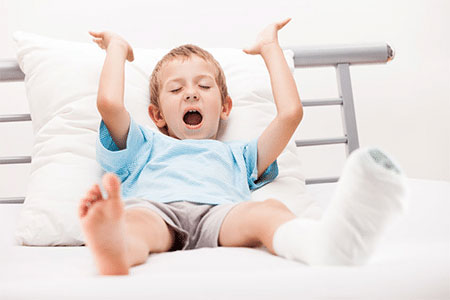
Providing your children with the correct type of shoes is one of the most basic and effective ways to ensure they avoid foot or leg injuries. In addition to finding a pair of shoes that provide good support, you need to make sure that the shoes fit the shape of your child’s feet perfectly. Certain shoes provide better support to your kids’ feet, by minimizing the impact that your kids’ feet and legs take every time they come in contact with the ground.
In children, most toe, foot, or ankle injuries occur during sports, play, or falls. The risk for injury is higher in sports with jumping, such as basketball, or sports with quick direction changes, such as soccer or football.
What Features Should Your Kids’ Running Shoes Provide?
If your children are into running, you need to provide them with shoes that provide two key features:
1️⃣ Shock Absorption: This feature minimizes the impact that your kids’ feet and legs take every time they come in contact with the ground.
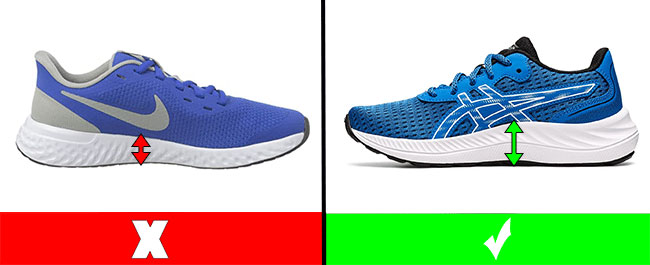
2️⃣ Firm Heel Counters: This feature provides good ankle support and prevents heel spurs.

The Importance of Fitting Your Kids’ Running Shoes Correctly
One of the most common mistakes I see parents make is to leave extra growing room in their kids’ shoes hoping they will last longer. I am always emphasizing to parents that they should replace their kids’ shoes as soon as they start feeling too small.
I’ll use an automobile tire as an example. If the wheels are out of alignment or improperly balanced, the tire will wear excessively on one side and very little on the other. The result is a tire life shorter than it would be with proper wheel alignment and balance. Tire tread and shoe tread operate on the same principle. Shoes fitted too long, too short, too narrow, or too wide, create a tread imbalance and a faulty wear pattern for the shoe itself.
If you fit your kids running shoes too long, you will compromise your child’s stability and make your child more prone to falling. The other downside of buying shoes for your child that are too large is that the shoe will have too much extra space around the ankles, which means the foot will move too much inside the shoe which can lead to ankle injuries.
If you fit your kids running shoes too short, you will end up cramping your kids’ toes and make them overlap one another or rub against the side of the shoes, which can lead to several foot problems such as bunions, calluses, corns, and ingrown toenails.

Do You Have Absolute Certainty About Your Child’s Foot Size
When it comes to protecting your young child from foot injuries, prevention is key. Keep in mind that properly fitting shoes are the only protective gear that children have to safeguard them from injury, and we must make sure that the shoes that they are wearing are fitting them properly.
I always recommend parents take their kids to be properly fitted for shoes at the local shoe store that they trust, where a shoe fitter can properly measure their feet and find shoes that fit.
The issue is that not all parents have a good-fitting children’s shoe store in their area. That is the reason why I decided to create a resource where I describe the best-fitting children’s local shoe stores by state.
If after looking at that resource you still can’t seem to find a kids’ shoe store in your area, then proceed to read an article I created where I describe the simplest, yet most effective way to figure out your child’s foot size from home.
In that article I help parents determine their child’s exact foot size and whether the child has narrow, medium, wide, or extra wide feet. I also will be able to tell you whether your child has a high instep or not.
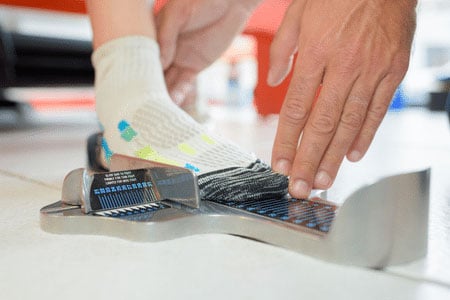
Besides causing pain and discomfort that can affect athletic performance, providing your children with the wrong shoe size can result in foot problems and cause further injuries down the road.
How to Stop Your Child’s Foot or Leg Pain? – Let’s Find Out!
Active children impose enormous abuse on shoes. The average child will take approximately 20,000 steps a day. Keep in mind that these are also not ordinary walking steps as taken by an adult, these are stomping, running, jumping, skidding, twisting, scuffing, kicking, etc.
Often generally explained as muscle ache, some of this pain might be due to “growing pains.” However, there is no actual evidence that these are linked to growth spurts. For the most part, children’s foot and leg pain might occur after intense childhood activities, such as overexertion or clumsiness, or after they engage in physical activity.
Your child is most likely engaging in sports, certainly at school and frequently in extracurricular activities and free time after school or on the weekend. If we are to rank sports as the highest and most common form of physical activity, parents must be aware that their children’s feet are subjected to enormous traumatic stress. This is because these activities call for different forms of physical action that impose torsions, shock impact, sudden-stop action, etc. on the foot.
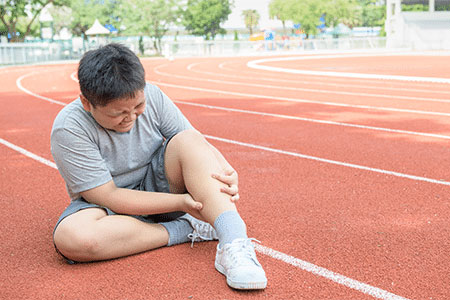
I have had several cases of children having knee pain and leg pain after engaging in more strenuous activities. However, these issues tend to diminish or disappear when children wear the correct type of shoes.
I will describe the most effective running shoes that will keep your children’s feet free from such pains after strenuous activities. Now that you know what features these running shoes will provide and how to figure out your child’s foot size from home, you are ready to take a look at a selection of the best running shoes to prevent foot injuries from running.
I only write reviews of shoe styles that I have fitted before, otherwise, I wouldn’t know how well-made they are, the amount of support that they provide, and how they fit.Disclosure: Some links in this post may be affiliate links and we may receive a small commission (at no extra cost to you) when you click our links and make purchases.
The Best Shoes to Prevent Foot Injuries from Running
These running shoes are engineered to provide the support, motion control, and cushioning that minimizes foot injuries associated with a particular activity. These shoes can fit children with medium (M), wide (W), or extra wide (XW) feet.
Little Kid Shoe Sizes (10.5 to 3)
- Shoe style Fresh Foam X 860v13
- Available in medium and wide widths
- Lace-up closure
- Fresh Foam midsole cushioning is precision engineered to deliver an ultra-cushioned, lightweight ride
- Ultra Heel design hugs the back of the foot for a snug, supportive fit
- Order this shoe half a size larger than your child’s current foot size
- Shoe style Fresh Foam Roav by New Balance
- Available in medium and wide widths
- Lace-up closure
- Fresh Foam midsole cushioning is precision engineered to deliver an ultra-cushioned, lightweight ride
- Ultra Heel design hugs the back of the foot for a snug, supportive fit
- Order this shoe half a size larger than your child’s current foot size
- Shoe style Kinvara 14 LLT by Saucony
- Available in medium and wide widths
- EVA midsole provides increased shock attenuation, responsive cushioning and lasting durability
- Cushioned footbed
- Order this shoe a whole size larger than your child’s current foot size
- Shoe style Wind 2.0 by Saucony
- Available in medium and wide widths
- EVA midsole provides increased shock attenuation, responsive cushioning and lasting durability
- Padded tongue and collar
- Cushioned footbed
- Order this shoe a whole size larger than your child’s current foot size
- Shoe style Fresh Foam X 860 V13 by New Balance
- Available in medium and wide widths
- Lace-up closure
- Dual-layer midsole construction featuring top-bed foam cushioning and underfoot Fresh Foam X
- Order this shoe half a size larger than your child’s current foot size
- Shoe style Fresh Foam X 860 V13 by New Balance
- Available in medium and wide widths
- Lace-up closure
- Fresh Foam midsole cushioning is precision engineered to deliver an ultra-cushioned, lightweight ride
- Order this shoe half a size larger than your child’s current foot size
- Shoe style Fresh Foam X 880v12 by New Balance
- Available in medium, wide, and extra wide widths (fits high insteps)
- Lace-up closure
- Dual-layer midsole construction featuring top-bed foam cushioning and underfoot Fresh Foam X
- Order this shoe half a size larger than your child’s current foot size
- Shoe style Fresh Foam X 860v13 by New Balance
- Available in medium and wide widths
- Lace-up closure
- Strong rubber outsole and cushioned midsoles
- Order this shoe half a size larger than your child’s current foot size
- Shoe style TR14 LTT by Saucony
- Available in medium and wide widths
- Lace-up closure
- Foam padding placed around your ankle collar and under the tongue for an incredibly comfortable fit and feel
- Comfort sockliner molds to your foot with padding in the heel for ultimate cushioning at heel-strike
- Engineered mesh for structure, stretch and enhanced breathability
- Order this shoe half a size larger than your child’s current foot size
- Shoe style Cohesion TR14 LTT by Saucony
- Available in medium and wide widths
- Lace-up closure
- Foam padding placed around your ankle collar and under the tongue for an incredibly comfortable fit and feel
- Comfort sockliner molds to your foot with padding in the heel for ultimate cushioning at heel-strike
- Engineered mesh for structure, stretch and enhanced breathability
- Order this shoe half a size larger than your child’s current foot size
Big Kid Shoe Sizes (3.5 to 7)
- Shoe style Fresh Foam Arishi by New Balance
- Available in medium and wide widths
- Lace-up closure
- Fresh Foam midsole cushioning is precision engineered to deliver an ultra-cushioned, lightweight ride
- Ultra Heel design hugs the back of the foot for a snug, supportive fit
- Order this shoe half a size larger than your child’s current foot size
- Shoe style Fresh Foam Arishi v4 by New Balance
- Available in medium, wide, and extra wide widths
- Lace-up closure
- Fresh Foam midsole cushioning is precision engineered to deliver an ultra-cushioned, lightweight ride
- Ultra Heel design hugs the back of the foot for a snug, supportive fit
- Order this shoe half a size larger than your child’s current foot size
- Shoe style Wind 2.0 by Saucony
- Available in medium and wide widths
- EVA midsole provides increased shock attenuation, responsive cushioning and lasting durability
- Padded tongue and collar
- Cushioned footbed
- Order this shoe a whole size larger than your child’s current foot size
- Shoe style Cohesion TR14 LTT by Saucony
- Available in medium and wide widths
- Foam padding placed around your ankle collar and under the tongue for an incredibly comfortable fit and feel
- Comfort sockliner molds to your foot with padding in the heel for ultimate cushioning at heel-strike
- Engineered mesh for structure, stretch and enhanced breathability
- Order this shoe half a size larger than your child’s foot size
- Shoe style FuelCell Rebel by New Balance
- Available in medium and wide widths (fits high insteps)
- Lace-up closure
- FuelCell foam delivers a propulsive feel to help drive you forward
- Order this shoe a whole size larger than your child’s current foot size
- Shoe style Rave Run v2 by New Balance
- Available in medium, wide, and extra wide widths (fits high insteps)
- Supportive outsole with firm heel counter
- Lightweight and flexible
- Order this shoe a whole size larger than your child’s current foot size
- Shoe style Fresh Foam X 880v12 by New Balance
- Available in medium and wide widths (fits high insteps)
- Lightweight EVA foam cushioning in the midsole and padded heel increases comfort
- Firm heel counter
- Supportive heel for active kids
- Breathable mesh upper
- Order this shoe a whole size larger than your child’s current foot size
- Shoe style Fresh Foam X 880v12 by New Balance
- Available in medium, wide, and extra wide widths (fits high insteps)
- Lace-up closure
- Dual-layer midsole construction featuring top-bed foam cushioning and underfoot Fresh Foam X
- Order this shoe a whole size larger than your child’s current foot size
- Shoe style Arishi Fresh Foam by New Balance
- Available in medium, wide, and extra wide widths (fits high insteps)
- Lace-up closure
- Lightweight mesh upper
- Fresh Foam midsole cushioning is precision engineered to deliver an ultra-cushioned, lightweight ride
- Order this shoe half a size larger than your child’s current foot size
- Shoe style Arishi Fresh Foam by New Balance
- Available in medium, wide, and extra wide widths (fits high insteps)
- Fresh Foam midsole cushioning is precision engineered to deliver an ultra-cushioned, lightweight ride
- Lightweight mesh upper
- Order this shoe a whole size larger than your child’s current foot size
- Shoe style Kinvara 14 LTT by Saucony
- Available in medium and wide widths (fits high insteps)
- Lace-up closure
- PWRRUN cushioning puts responsive energy under every stride
- Order this shoe half a size larger than your child’s current foot size
- Shoe style Kinvara 14 LTT by Saucony
- Available in medium and wide widths (fits high insteps)
- Lace-up closure
- PWRRUN cushioning puts responsive energy under every stride
- Order this shoe half a size larger than your child’s current foot size
Unsure About What Shoe Size You Should Order?
In each of the descriptions of the shoes, I indicate whether you need to order a half size or a whole size bigger than your child’s current foot size to provide the correct amount of growing room.
*A half a size bigger translates to 3/16 of an inch or 0.4 centimeters of space between your child’s longest toe and the end of the shoes.
*A whole size bigger translates to 3/8 of an inch or 0.8 centimeters of space between your child’s longest toe and the end of the shoes.
If your child happens to have narrow feet I suggest that you take a look at the article on the best narrow running shoes for kids.
Running Shoes for Kids – The 5 Most Important Features!
1️⃣ Substantial Outsoles: This feature will reduce the impact that your kids’ feet and legs take every time they become in contact with the ground.
2️⃣ Firm Heel Counters: This feature will protect and support your kids’ ankles as well as strengthen and straighten them.
3️⃣ Good traction: This will prevent your child from slipping and falling, especially when running fast.
4️⃣ Breathable: The shoes must be breathable to prevent the buildup of bacteria inside the shoe.
5️⃣ Shoelaces vs Velcro: I always recommend shoelaces instead of Velcro closure, especially when it comes to running shoes. Shoelaces will provide more support and stability to your child’s feet.
Do You Have Any Additional Questions or Concerns?
Do not hesitate to contact me directly if your child has narrow feet. I recommend running shoes that come with shoelaces instead of velcro closure since shoelaces provide better support and stability to your child’s feet.
Have you found a particular running shoe style that has worked well for your child’s feet? Please share your findings below so other parents can benefit from your experiences.


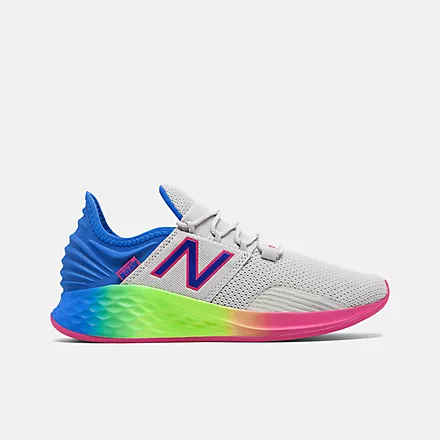




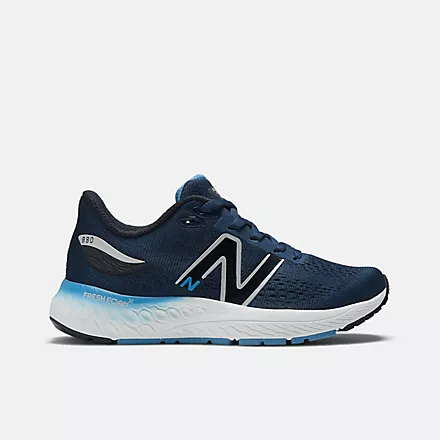
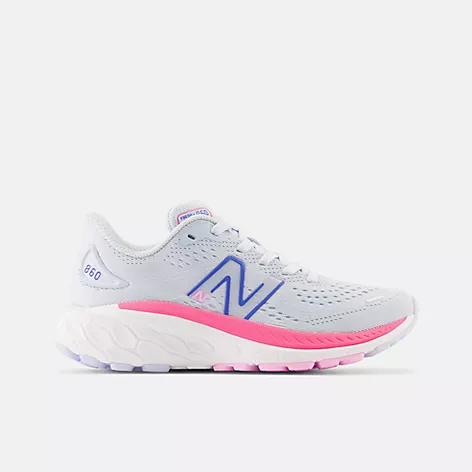


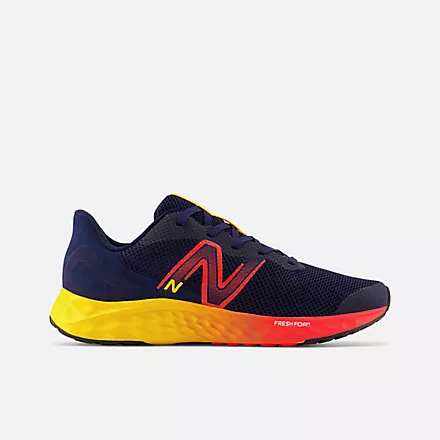
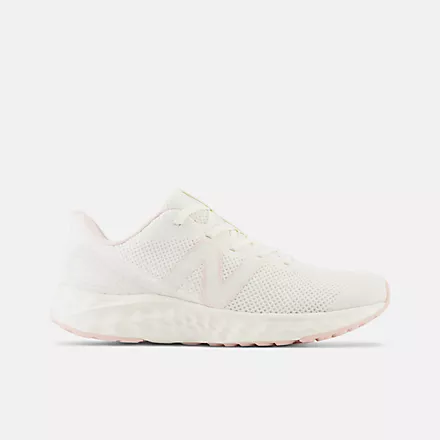

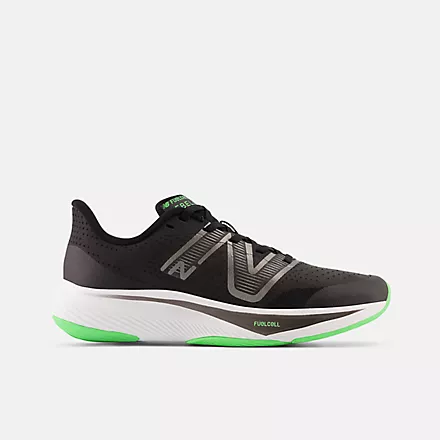

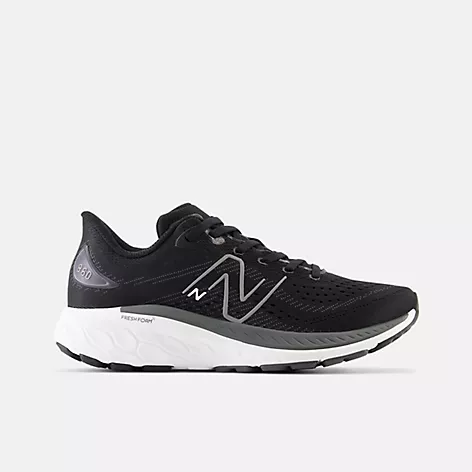
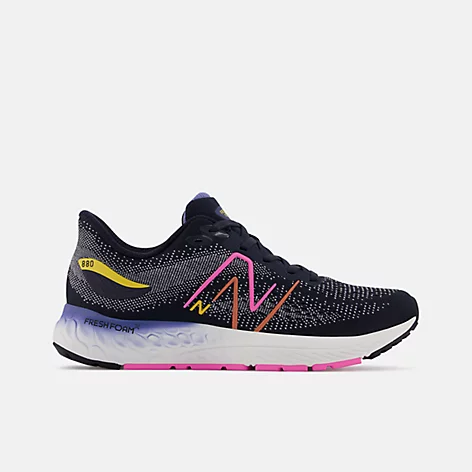



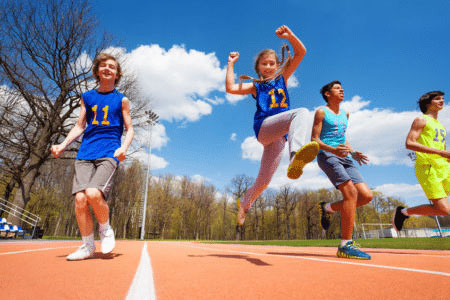
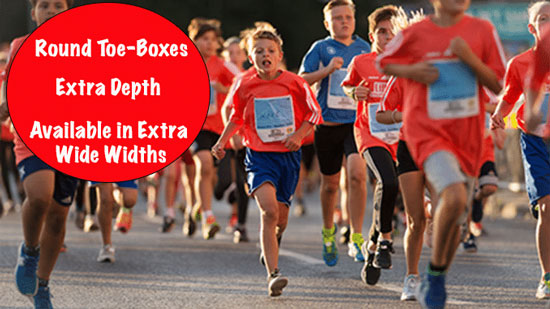
Every time I injured my foot it was just because I bumped into some type of furniture and stubbed my toe. I could probably say that I have big feet but the real issue I have is that I’m always walking around at my job up and down hills. Which if you think about it should be good for a little cardio right. I guess so but I may need to look for some new shoes because my foot aches sometimes when I walk too much.
Chris,
I can see where you are coming from.Working at a shoe store I am in my feet all day. Sitting down, getting up, climbing ladders to reach the shoes, running back and forth during the busiest days. It only took me 6 months from when I started working to start experiencing not only foot pain but knee and leg pain as well.
I decided to invest in a good pair of Asics and Super Feet insoles and the pain went away. In most cases, the pain might have gone away with a good supportive pair of shoes, but in my case I needed something extra.
Greetings Juan, as an independent soccer boot blogger myself, I notice that soccer boots have becoming more influential due to the designs rather than comfort.
I just want to share my opinion that they are willing to buy and get a shoe which might not be the right fitting due to the narrow-form nature of the shoe.
What I am trying to say is because the design is so appealing, they would sacrifice comfort and this backfires actually.
So much for the short-termism. Anyways, overall, comfort is still arguably an underrated factor which should be prioritized by all of us.
Thanks for sharing, Juan.
Tar
Tar,
I agree with you that some individuals prioritize looks over fit when it comes to shoes. I want to believe that this is not true, but in most instances it is. I am sure you have played soccer yourself and you understand the kind of pain you might suffer if you do not wear the appropriate pair if cleats. I am glad you found the post informative.
Your post on foot injuries from running was very informative. It was good to be reminded of the importance of properly fitted shoes. I must admit, I have been guilty of buying shoes on the bigger side, so they last longer. I won’t be doing that again! I was amazed to hear how many steps an average child takes in a day. I feel even more strongly now about getting properly fitted shoes, and the right shoes for particular activities. Thanks for the incredibly useful information.
Gemma,
I am glad you found the post informative and that it made you realize how important it is to provide your children with the right pair of shoes.
Hi Juan,
Your article on foot injury is most related to health. At some point of time we all got suffered from foot injury due to wrong shoe size and bad shoe material. Feet are the pillars of body, they must be healthy. Your broadly brought out all the possible injury linked to feet due to bad shoe selection.
As elders can select their shoe by their own but for kids parents must know the importance of shoe size, and must select the fitting one only.
Sam!
Sam,
I am glad you found the post informative. You are correct when you state that: “At some point of time we all got suffered from foot injury due to wrong shoe size and bad shoe material”, this can be avoided or minimized by wearing the right type of shoes.
This is a very informative article. Thanks for helping us see the value of fitting our children’s shoes. It seems like there would also be a need for kids having several different pairs of shoes if they are involved in multiple sports. The importance of taking care of our feet is something that most of us overlook on a daily basis. This neglect will come back and haunt us when we are old. It would be really helpful to our kids if we instill in them the habit of taking care of their feet at an early age. Thanks for the information.
Nancy,
I am glad you found the post informative. Depending on the age of the child, the level of competitiveness, and what the coach might want, there might be a need for different pair of shoes if they are involved in multiple sports. I agree with you that we need to take care of our feet on a daily basis! Thank you for stopping by.
Hi Juan: You are providing very valuable information on your site for parents with young children. It is important that parents understand the benefits of fitting their children with specialized shoes as they grow. I trust your site will be beneficial to your visitors as it is with me. Cheers.
Vena.
caringforcaregiver.com
Vena,
My goal is to explain the importance of fitting children’s shoes. I hope most parents will understand the benefits of fitting their children when it comes to shoes.
Dear Juan,
This is very helpful info indeed. I have to share this Website to a church friend of mine who is expecting a son soon. And, she needs all the help she can get since he will be her first child. 🙂
You are very right in terms of how many different pairs of shoes a child may go through during their childhood, it is an ongoing process of keeping them comfortable in the shoes they wear on their feet always.
Wow, 20,000 Steps a day, I do love walking a ton, but never realized that even I can take that many steps per day.
Thanks for raising awareness on how to deal with foot pain and injuries. 🙂
Wishing you all the best with your online success above and beyond the horizon,
~Angel
Angel,
I work in a children’s shoe store and I am on my feet all day. I can not tell you how hard it is to reach the 20,000 steps mark. Obviously children are stressing their feet and legs all day and we must provide them with the right pair of shoes so they can stay healthy and compete at their best!
This is the kind of information that every parent should have access to. I know I didn’t realise that sports shoes were so specialized. And you’re right about what children do to their shoes! 🙂
Margaret,
I am glad you found the information useful. As the child gets older and sports start being more competitive, I definitely recommend specialized shoes for each sport if you want them performing at their best.